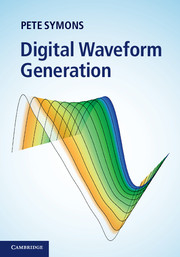Book contents
- Frontmatter
- Contents
- Preface
- Acknowledgements
- Glossary of terms
- 1 Introduction to waveform generation
- 2 The foundations of digital waveform generation
- 3 Recursive sine wave oscillators
- 4 DDS sine wave generation
- 5 DDS arbitrary waveform generation
- 6 Dynamic waveshape and spectrum control
- 7 Phase domain processing – DDS and the IDFT
- 8 Hardware implementation architectures
- 9 Digital to analogue conversion
- Index
- References
7 - Phase domain processing – DDS and the IDFT
Published online by Cambridge University Press: 05 November 2013
- Frontmatter
- Contents
- Preface
- Acknowledgements
- Glossary of terms
- 1 Introduction to waveform generation
- 2 The foundations of digital waveform generation
- 3 Recursive sine wave oscillators
- 4 DDS sine wave generation
- 5 DDS arbitrary waveform generation
- 6 Dynamic waveshape and spectrum control
- 7 Phase domain processing – DDS and the IDFT
- 8 Hardware implementation architectures
- 9 Digital to analogue conversion
- Index
- References
Summary
In Chapter 4 we introduced the idea of phase domain processing and outlined the permissible arithmetic operations that may be applied in a DDS context. In this chapter we apply simple multiplicative scaling of a phase sequence to combine DDS frequency synthesis (i.e. phase accumulation) with waveform synthesis based upon the inverse discrete Fourier transform (IDFT). This, in turn, enables computationally feasible real-time execution of the IDFT at any fundamental frequency and represents a powerful waveform generation technique. Waveform synthesis using the IDFT is fundamentally a frequency domain or spectrum specification method requiring multiple harmonic amplitude and phase parameters to specify the waveform. In a similar manner to the wavetable methods discussed earlier, we may also apply ‘spectral shaping’ (e.g. the Lanczos sigma function) to mitigate waveform ringing artefacts due to the Gibbs phenomenon. The fundamental frequency of the synthesised waveform may be programmed with all the advantageous attributes of DDS (e.g. phase continuity, linearity and arbitrarily fine frequency control). We now have a DDS arbitrary waveform generator with a fully parameterised IDFT phase–amplitude mapping algorithm.
Another application of phase domain processing, that we investigate further in Chapter 8, exploits the properties of a phase sequence formed by the addition of two separate sequences from coherent phase accumulators clocked at different sample frequencies with a radix-2 ratio. By appropriate partitioning of the input phase increment between the two phase accumulators, the frequency control resolution of the summed sequence is determined solely by the accumulator with the lower clock frequency. This technique may be used to significantly reduce the amount of fast logic needed in very high frequency phase accumulator designs, thereby optimising power consumption, heat dissipation and cost [1].
- Type
- Chapter
- Information
- Digital Waveform Generation , pp. 249 - 265Publisher: Cambridge University PressPrint publication year: 2013

